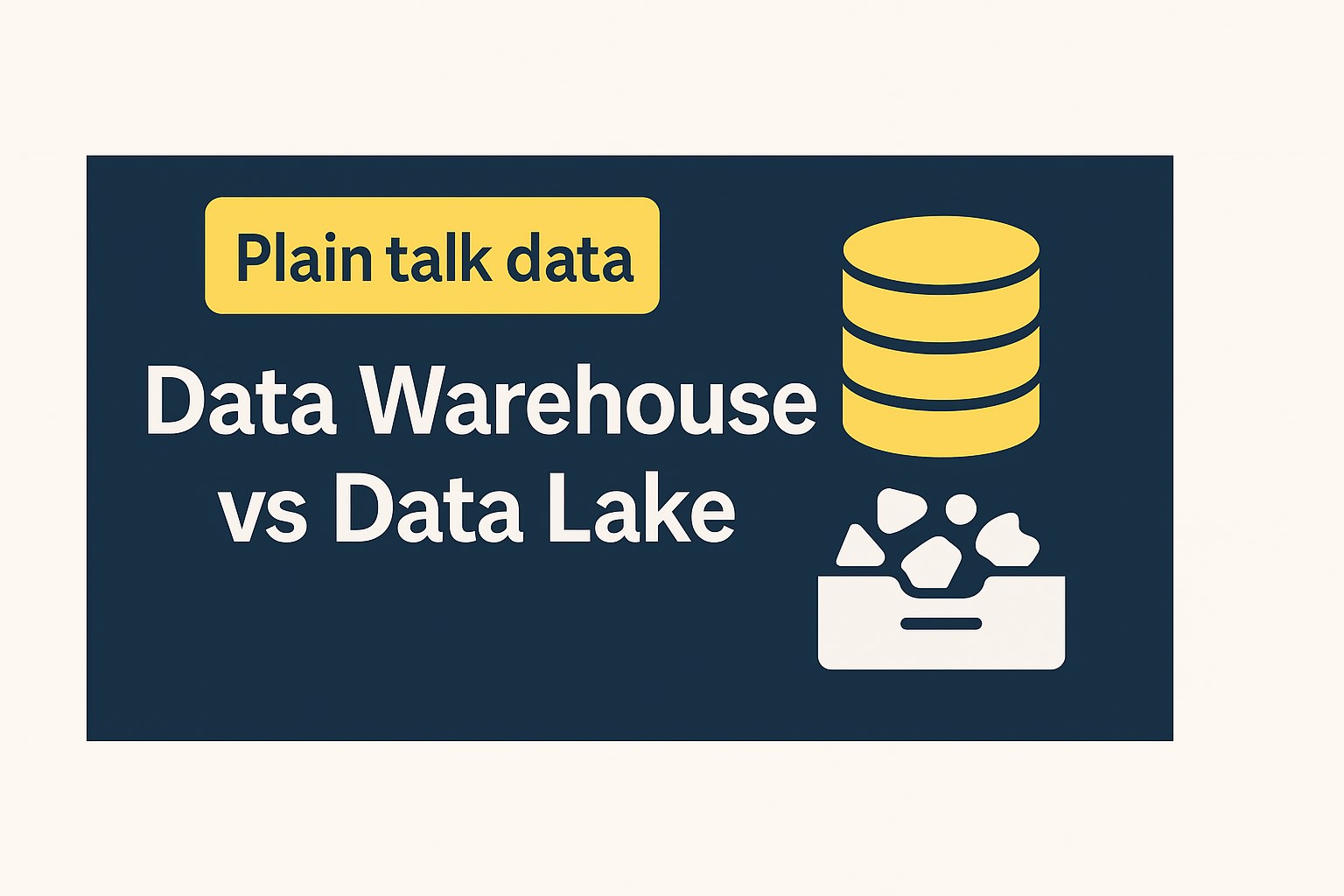Plain Talk Data: Data Warehouse vs Data Lake
A plain-English explanation of data warehouse vs data lake - organized garage vs junk drawer. Learn when to use each data storage approach.
Plain Talk Data: Data Warehouse vs Data Lake
Data Warehouse vs Data Lake = “Organized garage vs junk drawer”
Data Warehouse = The Neighbor’s Perfectly Organized Garage
Everything has a labeled spot. Screws are sorted by size in little containers. Tools hang on pegboards. You can find anything instantly, but you had to spend a weekend organizing it first, and you can only put things where they “belong.”
Characteristics:
- Data comes in messy, gets cleaned up and organized into neat tables
- Fast to find what you need because everything’s in its proper place
- Expensive to maintain (like buying all those label makers and storage bins)
- Great for answering the same questions over and over (“What were last month’s sales?”)
Best for:
- Regular business reports
- Historical trend analysis
- Structured data (numbers, dates, categories)
- Questions you ask repeatedly
- When speed matters more than flexibility
Data Lake = Your Actual Garage/Junk Drawer
You just toss stuff in there. Christmas decorations next to old tax returns next to that broken toaster you’ll “definitely fix someday.” Finding anything takes forever, but hey, at least you didn’t spend time organizing it.
Characteristics:
- Data gets dumped in exactly as it comes (photos, spreadsheets, sensor readings, whatever)
- Cheap storage (like shoving everything in cardboard boxes)
- Nightmare to find specific things unless you remember exactly where you put them
- Great for “I might need this someday” and data science experiments
Best for:
- Storing everything “just in case”
- Machine learning experiments
- Unstructured data (videos, documents, social media)
- Exploratory analysis
- When storage cost matters more than query speed
Real-World Translation
Data Warehouse Example
Your bank’s system that instantly tells you your balance, transaction history, and spending patterns. Everything is clean, organized, and lightning-fast.
Data Lake Example
Google Photos storing every random screenshot you’ve ever taken. It’s all there somewhere, but good luck finding that specific meme from 2019.
The Practical Reality
Most companies end up with both:
- The lake for “store everything cheap”
- The warehouse for “give me answers fast”
It’s like having:
- A junk drawer for random stuff you might need someday
- An organized filing cabinet for important documents you access regularly
Which One Do You Need?
Choose Data Warehouse if:
- You ask the same questions regularly
- You need fast, reliable answers
- Your data is mostly structured (spreadsheet-like)
- You have budget for setup and maintenance
- Business users need self-service analytics
Choose Data Lake if:
- You’re not sure what questions you’ll ask
- You have lots of different data types
- Storage cost is a major concern
- You’re doing data science or machine learning
- You want to keep everything “just in case”
Choose Both if:
- You have the budget and complexity to manage both
- You need fast answers AND flexible exploration
- You want the best of both worlds
The Bottom Line
Data Warehouse: Expensive but fast and organized
Data Lake: Cheap but slow and messy
Think of it as the difference between a five-star restaurant (everything perfect but pricey) and a food truck (good enough and affordable). Both serve food, but for different occasions and budgets.
The key is matching your choice to your actual needs, not just picking what sounds cooler.
